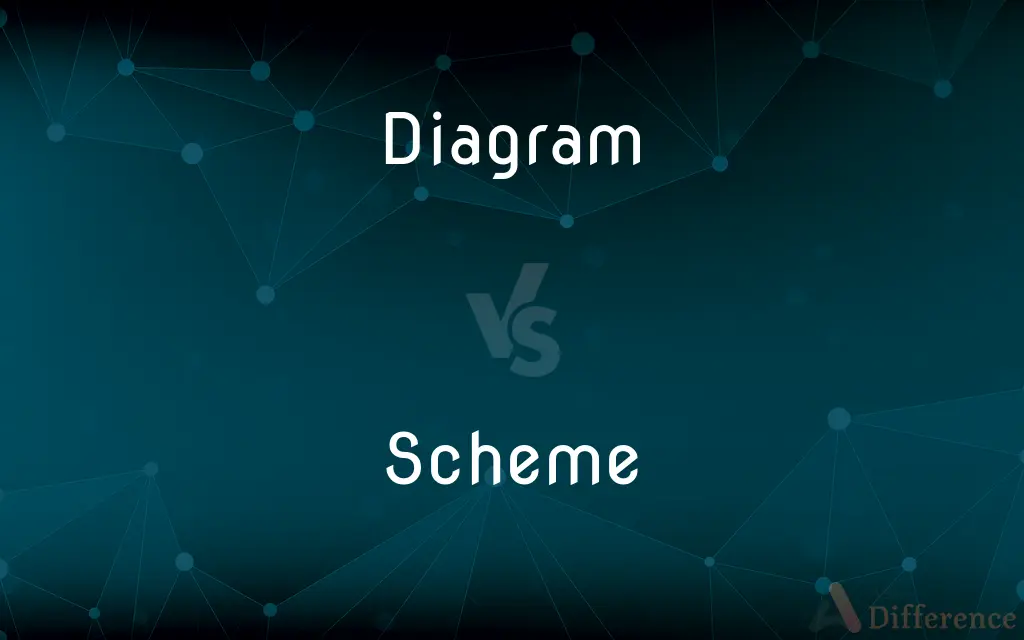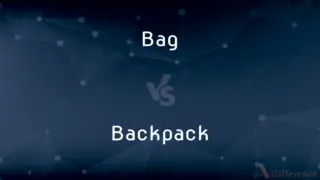Diagram vs. Scheme — What's the Difference?
Edited by Tayyaba Rehman — By Maham Liaqat — Updated on March 17, 2024
Diagram visually represents information with shapes, lines, and symbols to illustrate a concept or process, focusing on clarity & detail. Scheme, on the other hand, often outlines plan or design, highlighting relationships or arrangements more abstractly.

Difference Between Diagram and Scheme
Table of Contents
ADVERTISEMENT
Key Differences
Diagrams are used extensively in education, engineering, and science to depict the structure, workflow, or relationship between different components in a clear and detailed manner. Schemes, while similar, tend to represent plans, projects, or systems in a more general and abstract way, focusing on the overarching structure or strategy rather than the intricate details.
In terms of function, diagrams are primarily concerned with explaining how something works or is structured, often used to visualize data, concepts, or steps in a process. They serve as educational tools that enhance comprehension and retention. Schemes, however, are more likely to outline a course of action, a methodology, or a systematic plan, serving as a guide for implementation or understanding of a broader concept or project. They might not always require the same level of detail or specificity as diagrams.
The creation of a diagram usually involves specific conventions and symbols relevant to its field, such as electrical symbols in circuit diagrams or standardized shapes in flowcharts. These conventions ensure that diagrams convey precise and uniform information. Schemes may also use symbols and conventions, but the emphasis is on the representation of ideas, principles, or relationships, which can afford a greater level of abstraction or simplification.
Audience engagement with diagrams is often analytical or instructional, aiming to dissect or understand specific aspects of a subject. Diagrams invite viewers to explore details, understand processes, and grasp complex information through visualization. Conversely, engagement with schemes is more strategic or conceptual, inviting viewers to grasp overall plans, relationships, or frameworks, often requiring a higher level of interpretation or synthesis of information.
While diagrams and schemes both utilize visual elements to communicate information, their intents diverge significantly. Diagrams focus on detail, precision, and clarity in representation, facilitating understanding of complex subjects. Schemes emphasize the organization, planning, and abstract relationships within a concept, often serving as a guide or overview rather than an exhaustive depiction.
ADVERTISEMENT
Comparison Chart
Definition
A visual representation that illustrates a concept or process with detail and clarity.
An abstract representation of a plan, design, or theory, focusing on relationships and arrangements.
Purpose
To simplify and clarify complex information.
To outline or conceptualize plans or systems.
Detail Level
High, with emphasis on clarity and precision.
Lower, with a focus on general structure and relationships.
Use Cases
Education, engineering, science.
Strategic planning, organizational design, theoretical frameworks.
Symbolism
Specific symbols and conventions per field.
More abstract, with flexible representation of ideas.
Audience Engagement
Analytical or instructional, focusing on understanding details.
Strategic or conceptual, focusing on overarching plans or ideas.
Focus
Detail, structure, and process.
Relationships, strategies, and overarching concepts.
Compare with Definitions
Diagram
A graphical representation showing how a system works.
A circuit diagram for an electronic device.
Scheme
A plan or diagram showing the main features of a system.
A scheme of a company’s organizational structure.
Diagram
Focuses on precision and accuracy in depiction.
An architectural diagram of a building’s design.
Scheme
Emphasizes the big picture and relationships.
A scheme of an urban development plan.
Diagram
Aids in visualizing complex data or relationships.
A Venn diagram comparing different data sets.
Scheme
Outlines strategies or frameworks.
A marketing strategy scheme.
Diagram
Used to explain detailed structures or processes.
A skeletal system diagram in a biology textbook.
Scheme
Used to represent concepts or plans more abstractly.
A color scheme for a website’s design.
Diagram
Employs specific symbols for clarity and uniformity.
A chemical structure diagram using standard chemistry symbols.
Scheme
May use symbols to depict relationships and processes.
A scheme illustrating a scientific theory.
Diagram
A diagram is a symbolic representation of information using visualization techniques. Diagrams have been used since ancient times on walls of caves, but became more prevalent during the Enlightenment.
Scheme
A systematic plan of action
"Did you ever carry out your scheme of writing a series of sonnets embodying all the great epochs of art?" (Edith Wharton).
Diagram
A simplified drawing showing the appearance, structure, or workings of something; a schematic representation
A diagram of the living room
Scheme
A secret or devious plan; a plot
A scheme to defraud investors.
Diagram
Represent (something) in graphic form
The experiment is diagrammed on page fourteen
Scheme
An orderly plan or arrangement of related parts
An irrigation scheme with dams, reservoirs, and channels.
Diagram
A plan, sketch, drawing, or outline designed to demonstrate or explain how something works or to clarify the relationship between the parts of a whole.
Scheme
A chart, diagram, or outline of a system or object.
Diagram
(Mathematics) A graphic representation of an algebraic or geometric relationship.
Scheme
To contrive a plan or scheme for; plot
Scheming their revenge.
Diagram
A chart or graph.
Scheme
To make plans, especially secret or devious ones.
Diagram
To indicate or represent by or as if by a diagram.
Scheme
An artful deviation from the ordinary arrangement of words.
Diagram
A plan, drawing, sketch or outline to show how something works, or show the relationships between the parts of a whole.
Electrical diagrams show device interconnections.
Scheme
(astrology) A representation of the aspects of the celestial bodies for any moment or at a given event.
Diagram
A graph or chart.
Scheme
A systematic plan of future action.
Diagram
(category theory) A functor from an index category to another category. The objects and morphisms of the index category need not have any internal substance, but rather merely outline the connective structure of at least some part of the diagram's codomain. If the index category is J and the codomain is C, then the diagram is said to be "of type J in C".
Scheme
A plot or secret, devious plan.
Diagram
(transitive) To represent or indicate something using a diagram.
Scheme
An orderly combination of related parts.
Diagram
(UK) To schedule the operations of a locomotive or train according to a diagram.
Scheme
A chart or diagram of a system or object.
Diagram
A figure or drawing made to illustrate a statement, or facilitate a demonstration; a plan.
Scheme
(mathematics) A mathematical structure that enlarges the notion of algebraic variety in several ways, such as taking account of multiplicities and allowing "varieties" defined over any commutative ring (e.g. Fermat curves over the integers).
Diagram
Any simple drawing made for mathematical or scientific purposes, or to assist a verbal explanation which refers to it; a mechanical drawing, as distinguished from an artistical one.
Scheme
A council housing estate.
Diagram
To put into the form of a diagram.
Scheme
(internet) Part of a uniform resource identifier indicating the protocol or other purpose, such as
http: or news:.Diagram
A drawing intended to explain how something works; a drawing showing the relation between the parts
Scheme
A portfolio of pension plans with related benefits comprising multiple independent members.
Diagram
Make a schematic or technical drawing of that shows how things work or how they are constructed
Scheme
(intransitive) To plot, or contrive a plan.
Scheme
(transitive) To plan; to contrive.
Scheme
A combination of things connected and adjusted by design; a system.
The appearance and outward scheme of things.
Such a scheme of things as shall at once take in time and eternity.
Arguments . . . sufficient to support and demonstrate a whole scheme of moral philosophy.
The Revolution came and changed his whole scheme of life.
Scheme
A plan or theory something to be done; a design; a project; as, to form a scheme.
The stoical scheme of supplying our wants by lopping off our desires, is like cutting off our feet when we want shoes.
Scheme
Any lineal or mathematical diagram; an outline.
To draw an exact scheme of Constantinople, or a map of France.
Scheme
A representation of the aspects of the celestial bodies for any moment or at a given event.
A blue silk case, from which was drawn a scheme of nativity.
He forms the well-concerted scheme of mischief;'T is fixed, 't is done, and both are doomed to death.
Artists and plans relieved my solemn hours;I founded palaces, and planted bowers.
Scheme
To make a scheme of; to plan; to design; to project; to plot.
That wickedness which schemed, and executed, his destruction.
Scheme
To form a scheme or schemes.
Scheme
An elaborate and systematic plan of action
Scheme
A statement that evades the question by cleverness or trickery
Scheme
A group of independent but interrelated elements comprising a unified whole;
A vast system of production and distribution and consumption keep the country going
Scheme
An internal representation of the world; an organization of concepts and actions that can be revised by new information about the world
Scheme
A schematic or preliminary plan
Scheme
Form intrigues (for) in an underhand manner
Scheme
Devise a system or form a scheme for
Common Curiosities
Is a flowchart a diagram or a scheme?
A flowchart is a type of diagram that represents a process or workflow in detail, making it a diagram by definition.
How does a scheme differ from a detailed plan?
A scheme outlines the main features and relationships in a plan or system, often in a more abstract way, while a detailed plan includes specific steps, actions, and details.
How are diagrams used in education?
Diagrams are used to simplify complex subjects, illustrate concepts, and aid in visual learning and comprehension.
What role do schemes play in project management?
In project management, schemes outline the project’s structure, phases, and key relationships, serving as a roadmap for project execution and strategic alignment.
What is the primary purpose of a diagram?
To visually explain and clarify the structure, process, or relationship between different elements of a concept in detail.
Are there any fields where both diagrams and schemes are equally important?
Yes, in fields like architecture, urban planning, and engineering, both diagrams and schemes are crucial for detailing specific designs and outlining overall concepts or plans.
Can schemes be misleading if not accurately represented?
Yes, if a scheme is overly simplified or inaccurately represents relationships or concepts, it can lead to misunderstandings or flawed strategic planning.
Can a diagram be part of a scheme?
Yes, diagrams can be used within schemes to illustrate specific aspects or components of the overall plan or system.
Why might someone use a scheme in strategic planning?
Schemes help visualize the overarching structure, relationships, and strategies within a plan, aiding in conceptual understanding and strategic decision-making.
How do diagrams aid in problem-solving?
Diagrams help break down complex problems into manageable parts, visualize relationships and processes, and facilitate identification of key components and potential solutions.
Is there a specific format or standard for creating diagrams?
Yes, many fields have specific standards and conventions for creating diagrams to ensure clarity, uniformity, and accurate communication of information.
How can a scheme support innovation and creativity?
Schemes can provide a high-level overview that highlights relationships and potential synergies, fostering creative thinking and innovative solutions by allowing for abstract and strategic visualization.
How do symbols function differently in diagrams and schemes?
In diagrams, symbols have specific, standardized meanings to convey precise information, while in schemes, symbols may be more abstract, representing concepts or relationships more generally.
What are the limitations of using diagrams?
Diagrams can sometimes oversimplify complex realities, may require specialized knowledge to interpret correctly, and might not capture dynamic processes effectively.
Share Your Discovery

Previous Comparison
Foggy vs. Cloudy
Next Comparison
Bag vs. BackpackAuthor Spotlight
Written by
Maham LiaqatEdited by
Tayyaba RehmanTayyaba Rehman is a distinguished writer, currently serving as a primary contributor to askdifference.com. As a researcher in semantics and etymology, Tayyaba's passion for the complexity of languages and their distinctions has found a perfect home on the platform. Tayyaba delves into the intricacies of language, distinguishing between commonly confused words and phrases, thereby providing clarity for readers worldwide.
















































